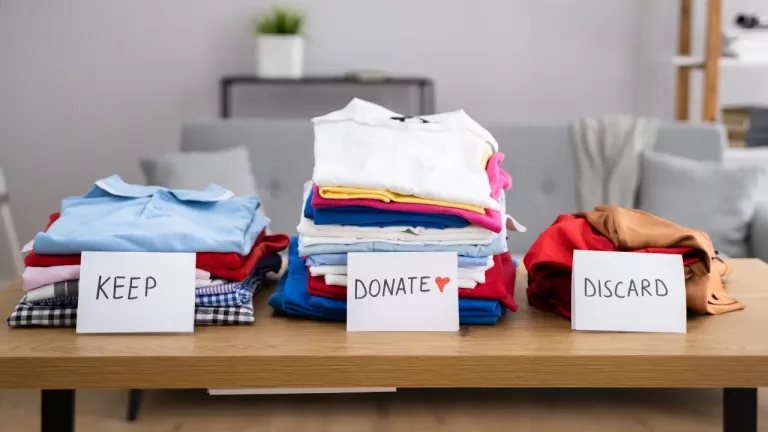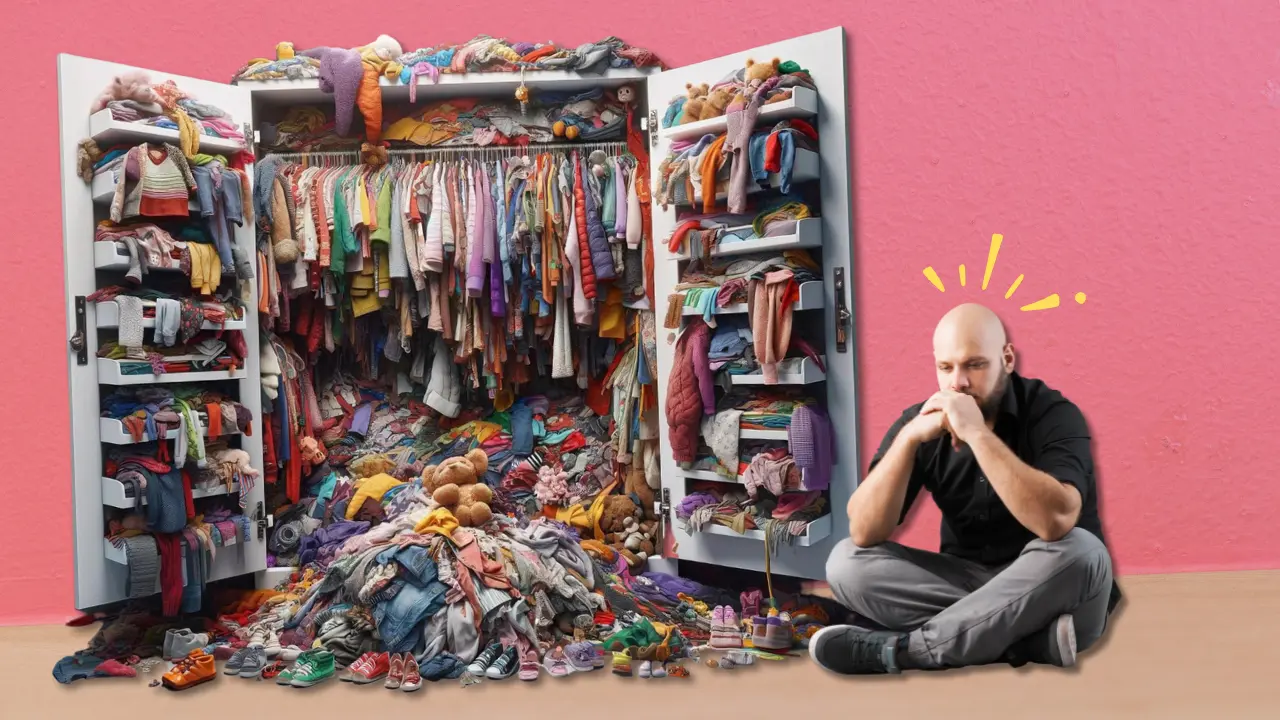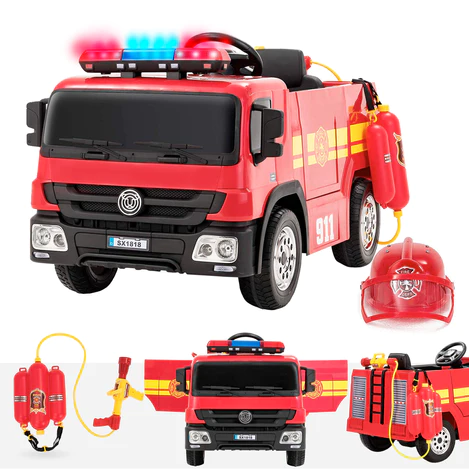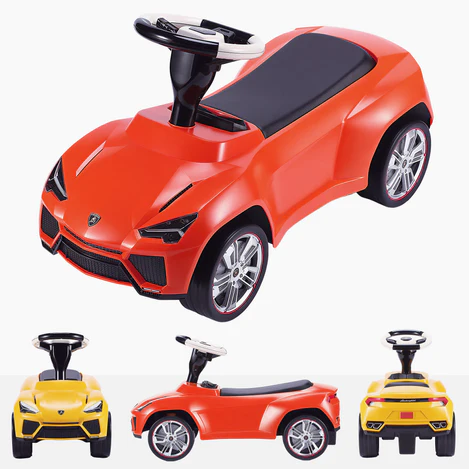As parents, managing our children’s constantly evolving needs, especially when it comes to their wardrobes, can feel a little like being caught in a landslide.
The goal to save on kids’ clothing becomes even more crucial as we navigate through the endless cycle of growth spurts, resulting in piles of outgrown clothes and the daunting challenge of keeping everything organised.
With each growth spurt, we’re faced with piles of outgrown clothes and the challenge of keeping everything organised.
This article will guide you through effective strategies to keep your kids’ wardrobes manageable, organised, and functional, no matter how fast they grow.
Table of Contents
ToggleRegular Decluttering: The Foundation of Wardrobe Management
Regular decluttering is key in kids wardrobe organisation.
Sort through your child’s clothes and organise kids clothes into categories: keep, donate, and recycle.
This process, often part of a kids room decluttering challenge, not only manages children’s closet organisation but also teaches them valuable lessons in decluttering kids wardrobes.

The necessity of decluttering
Decluttering isn’t just about creating space; it’s about maintaining a wardrobe that grows with your child.
Regular decluttering ensures that you’re only keeping what’s necessary and useful.
Seasonal sorting
A practical approach involves a bi-annual sorting routine.
As the seasons change, so do the clothing needs of your child.
Sort their clothes into three categories: items to donate, pieces to hand down, and worn-out items for recycling.
This not only clears space but also keeps the wardrobe updated and manageable.
Storage Solutions: Organising for Growth
Innovative kids clothing storage ideas like using childrens wardrobe drawers and kids dress drawer organisation can be a game-changer.
Storing seasonal clothing
It’s essential to have a system for storing clothes that are currently too big or out of season.
Use small, clearly labelled bins for each child, storing clothes for upcoming seasons or growth phases.
This foresight saves time and money in the long run.
Organising hand-me-downs
If you have multiple children, organising hand-me-downs can be a game-changer.
Label bins by size and season and keep them in the younger child’s closet.
This makes the transition of clothes from one child to the next seamless.
Setting Limits: A Key to Efficient Wardrobes
Importance of limits
Setting limits is crucial.
It’s easy to accumulate more clothes than necessary.
By setting clear boundaries on the number of items, you not only keep the wardrobe manageable but also teach your kids the value of simplicity.
Teaching organisation skills
Encourage your kids to take part in organising their clothes.
This not only eases your burden but also instils organisational skills in them.
Show them how to arrange their clothes, which helps in maintaining an orderly space.

Involving kids in decision-making
Involving your children in decision-making processes regarding their wardrobe is not just about giving them a choice in what they wear.
It’s an opportunity to teach them about organisation, decision-making, and even financial responsibility.
Here’s how you can do it:
- Choice in selection: When shopping, let your children have a say in what clothes are bought. This teaches them about making choices and also ensures they’re more likely to wear what is purchased.
- Understanding value: Discuss with them the cost of clothes and the value of money. This can be a basic introduction to budgeting and understanding the worth of items.
- Responsibility in care: Teach them to take care of their clothes. Explain how proper care extends the life of their garments, fostering a sense of responsibility.
This approach not only keeps the wardrobe under control but also imparts important life lessons to your children.
Maximising Space: Smart Strategies for Small Areas
Utilise wardrobe space-saving ideas such as kids clothes hanging solutions and children’s clothing drawer dividers.
Kids wardrobe storage and kids closet systems can be customised to fit your child’s growing needs, making wardrobe organisation hacks an essential part of kids room organisation.
Closet organisers are invaluable in managing your child’s growing wardrobe.
They not only optimise space but also make it easier to keep clothes accessible and organised.
Here are some key strategies for effectively utilising closet organisers:
Hanging organisers: Hanging organisers with multiple compartments are ideal for storing accessories, socks, and underwear. You can hang them on the inside of closet doors or in the main closet area. This makes it easy for your child to find what they need without rummaging through drawers.
Shelves and cubbies: Installing shelves or cubbies in the closet provides designated spaces for folded clothes, shoes, and bins. Use clear bins or baskets to store smaller items like toys or seasonal accessories. Labeling these containers helps both you and your child quickly identify what’s inside.
Drawer dividers: Within drawers, consider using drawer dividers or organisers to separate clothing items neatly. This prevents clothes from getting jumbled together and simplifies the process of selecting outfits.
Clothing rods: Adjustable clothing rods allow you to hang clothes at different heights, accommodating your child’s changing wardrobe needs as they grow. Reserve higher rods for longer items and lower rods for shorter ones.
Color coding and labels: Use a color-coding system or labels to categorise different types of clothing. For instance, assign a color to everyday wear, school uniforms, or special occasion outfits. This makes it easier for your child to find specific items quickly.
Customisation: Involve your child in customising their closet organisers. Let them choose colors or decorative elements for hangers, bins, or labels. This personal touch can make them more enthusiastic about keeping their wardrobe organised.
Remember that the key to effective closet organisation is consistency.
Encourage your child to return items to their designated spots after use to maintain the order and accessibility of their wardrobe.
Seasonal rotation: Keeping the wardrobe fresh and functional
Seasonal rotation of your child’s wardrobe is a practical strategy to ensure that their closet remains organised and functional throughout the year.
Here’s how to approach it:
Sort by season: Begin by categorising your child’s clothing into seasonal groups, such as spring/summer and fall/winter. This helps you identify which items are currently in use and which are not.
Storage space: Allocate a separate storage area, like bins or shelves, for out-of-season clothes and shoes. Ensure that these items are clean and properly folded or hung before storing them. Vacuum-sealed bags can help save space and protect the clothes from dust and moisture.
Regular assessments: As the seasons change, assess your child’s wardrobe to determine what still fits and what needs replacement. This prevents overcrowding and ensures that your child always has appropriately sized clothing.
Donate or pass on: If your child has outgrown clothes that are still in good condition, consider donating them to charity or passing them on to friends or family with younger children. This not only helps others but also declutters your child’s wardrobe.
Label and rotate: Label bins or containers with the contents’ season to make it easy to identify and switch out clothes. Rotate the clothing as the new season approaches, bringing the appropriate items back into the main closet.
Quality check: While rotating, inspect the condition of stored clothes. Check for any damage or signs of wear. If necessary, repair or replace items to ensure they are ready for the next season.
Implementing a seasonal rotation system allows you to ensure that your child’s closet is always stocked with the right clothes for the current weather, reducing clutter and simplifying the morning routine.
It’s an efficient way to keep the wardrobe fresh and functional year-round.
Teaching Kids to Organise: Empowering the Young Ones
Child involvement in organisation
Allow your children to pick out their own closet organisers.
This involvement makes the organising process fun and encourages them to keep their clothes in order.
Building long-term organisational skills
Such practices are not just about keeping a tidy closet; they’re about teaching valuable life skills.
Organisational skills learned early on can benefit your children in many aspects of their lives.
Eco-friendly practices in wardrobe management
Adopting children’s clothing hacks like kids clothes upcycling ideas and focusing on sustainable children’s wardrobe ideas can significantly contribute to an eco-friendly approach.
Here’s how you can do this:
- Opt for sustainable materials: When buying new clothes, look for items made from sustainable materials like organic cotton or recycled fabrics.
- Encourage upcycling: Teach your children about upcycling old clothes. This can be a fun activity where creativity meets sustainability.
- Support ethical brands: Choose to buy from brands that are known for their ethical practices and sustainability.
Long-Term Clothing Investment Strategies
Kids wardrobe tips include investing in adjustable and durable clothing.
Buying clothes ahead for kids and considering kids seasonal clothing storage are part of efficient wardrobe organisation.
Kids wardrobe hacks can also involve organising kids clothes by type and colour coding kids clothes for ease of selection.
Here are some strategies:
- Choose quality over quantity: Invest in higher-quality items that might cost more upfront but last longer, reducing the need for frequent replacements.
- Look for versatility: Buy clothes that are versatile and can be mixed and matched easily. This reduces the number of items needed.
- Plan for growth: Select clothes with adjustable features, like adjustable waistbands in trousers, which can accommodate your child’s growth for a longer period.
In Summary:
Managing your kids’ growing wardrobes doesn’t have to be a daunting task.
With regular decluttering, smart storage solutions, setting limits, maximising space, and involving your children in the process, you can keep their wardrobes in check.
These strategies not only create a more organised space but also teach your children valuable lessons in organisation and simplicity.
Remember, an organised wardrobe leads to a simpler, more manageable daily routine, giving you and your children more time to enjoy the precious moments of childhood.
FAQ's:
It’s recommended to declutter your child’s wardrobe at least twice a year, typically in the spring and fall. This aligns with seasonal changes and helps keep their clothing organised and up-to-date.
To store out-of-season clothes efficiently, use small, clearly labeled bins for each child. Place these bins in a designated storage area, ensuring that the clothes are easily accessible when the season changes.
Encourage your child to be a part of the organisation by letting them pick out clothing organisers such as hangers, baskets, or colorful labels. This not only empowers them but also makes the process fun and engaging.
To maximise closet space, use hanging organisers, shelves, and labels. Seasonally rotate your child’s clothes, storing out-of-season items in another area. This ensures that the closet remains organised and spacious.


